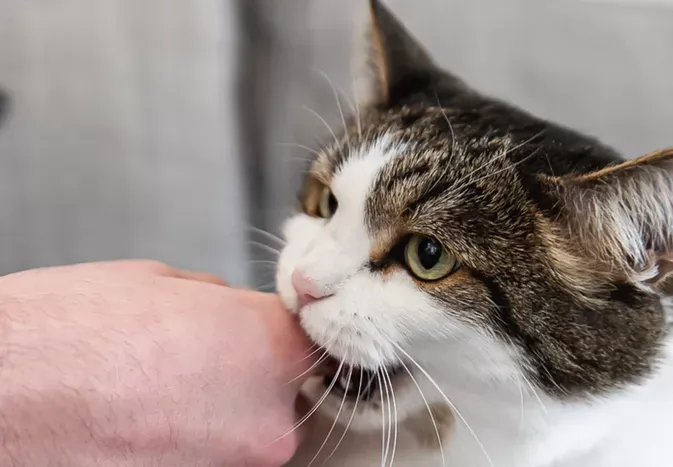Reasons Why Cats Bite and How to Stop It
Updated on 04/26/24

Unlocking the Enigma: Understanding Why Cats Bite and Unveiling Solutions to End the Nibbling
Cats, with their enigmatic personalities and adorable quirks, often leave us bewildered when they suddenly resort to biting. This seemingly aggressive behavior can range from playful nips to painful attacks, leaving us wondering what triggers our furry companions. In this comprehensive guide, we delve into the intricate reasons why cats bite and unveil practical strategies to effectively curb this undesirable behavior.
Understanding the Triggers: Exploring the Underlying Causes of Cat Bites
Cats resort to biting for a multitude of reasons, each requiring a tailored approach to resolution. Identifying the underlying cause is crucial for implementing the most effective intervention.
* Playful Aggression: Young cats often exhibit playful biting as a way to engage in mock combat and explore their surroundings.
* Fear or Anxiety: When cats feel threatened or anxious, they may bite as a defensive mechanism to protect themselves.
* Overstimulation: Excessive petting or handling can lead to overstimulation in some cats, causing them to bite as a way to communicate their distress.
* Medical Conditions: Underlying medical issues, such as dental pain or infections, can cause discomfort and irritability, prompting cats to bite.
* Misdirected Aggression: Cats may redirect their aggression towards inanimate objects or people when they're frustrated or unable to access the source of their frustration.
Tailoring Solutions: Strategies for Curbing Cat Bites
Addressing cat bites requires a multifaceted approach that considers the underlying cause and employs positive reinforcement techniques.
* Playtime Management: Allocate ample time for interactive play sessions to provide outlets for your cat's playful aggression. Use wand toys or laser pointers to stimulate their hunting instincts without exposing them to potential harm.
* Safe Havens and Retreats: Create designated safe spaces for your cat where they can retreat when feeling overwhelmed or anxious. Provide hiding places, such as cat caves or tunnels, to reduce stress and prevent potential biting incidents.
* Respecting Boundaries: Pay attention to your cat's body language and cues to avoid overstimulation. Observe when your cat begins to show signs of discomfort, such as flattening their ears or flicking their tail, and provide space accordingly.
* Medical Evaluation: If your cat exhibits sudden or persistent biting behavior, it's crucial to schedule a veterinary checkup to rule out underlying medical conditions that may be contributing to discomfort or irritability.
* Consistent Discipline: When a cat bites, respond calmly but firmly. Avoid harsh punishments or physical retaliation, as these can worsen the situation. Instead, use a firm "no" or "ouch" to communicate your disapproval.
* Positive Reinforcement: Reward your cat with treats, praise, or playtime whenever they exhibit appropriate behavior, such as playing gently or seeking affection without biting. Positive reinforcement encourages desired behaviors and reinforces the bond between you and your feline companion.
Case Studies: Practical Examples to Illustrate Effective Solutions
To further illustrate the effectiveness of these strategies, let's examine a few case studies:
* Case Study 1: Playful Biting: Maya, a 6-month-old kitten, exhibited excessive playful biting during playtime. By providing her with ample interactive play sessions and redirecting her energy towards appropriate toys, the biting was reduced significantly.
* Case Study 2: Fear-Induced Biting: Max, a 10-year-old cat, developed a fear of strangers and would bite when approached. By creating a safe haven in a quiet room and gradually introducing visitors while providing Max with a treat or toy as a distraction, his anxiety levels decreased, and the biting behavior subsided.
* Case Study 3: Overstimulation: Bella, a 5-year-old cat, would bite when petted excessively. By respecting her boundaries, providing her with designated retreat spaces, and redirecting her attention to interactive play, Bella's overstimulation was managed, eliminating the biting behavior.
Conclusion: Fostering a Bite-Free Relationship
Understanding the reasons behind cat bites and implementing tailored solutions is paramount for creating a harmonious relationship with your feline companion. By addressing underlying triggers, providing safe and engaging environments, and employing consistent and positive reinforcement techniques, you can effectively curb cat bites and foster a mutually fulfilling bond that transcends this occasional challenge.
Explore More Pets

Cat Behavior Problems
How to Stop Aggression in Kittens

Long-Haired Cat Breeds
Siberian Cat: Breed Profile, Characteristics, & Care

Cat Behavior Problems
How to Stop Kittens From Scratching and Biting

Long-Haired Cat Breeds
Turkish Angora: Cat Breed Profile, Characteristics & Care

Basic Training
How to Socialize Your Kitten

Short-Haired Cat Breeds
Cute Pictures & Facts About Calico Cats & Kittens

Litter Box Training
Training Your Kitten to Use the Litter Box

Long-Haired Cat Breeds
10 Fun Facts About White Cats